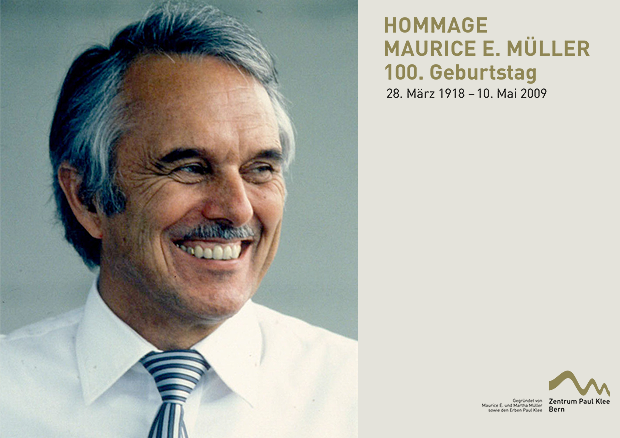South hill
Homage Maurice E. Müller 100th birthday
Maurice Müller and his artists
Maurice E. Müller the realizer of utopia
Maurice E. Müller was celebrated with numerous honorary doctorates as “orthopedist of the 20th century.” But he always remained apprehensive of resting on one’s laurels. Therefore he constantly was on the lookout for new challenges after retiring from his medical profession. What he then took up was no less than the realization of a utopia – the dream of a fundamentally different kind of museum. Dreaming of a new kind of museum was all the rage in the 1990s. Frank Gehry’s planned Guggenheim Center was in everybody’s mouths then. It was intended to be built on stilts on Manhattan harbor and bring together all facets of culture, featuring sports grounds, entertainment hubs, and shopping malls. Maurice E. Müller stripped the Guggenheim concept of its extravagance and non-serious elements and created in its place a venue dedicated to Paul Klee. He was fascinated by this artist and how he painstakingly kept records of his work. The building was not only to become a center for culture and events, doing justice to Paul Klee’s manifold talents. It was likewise to house a children’s museum – based on the ideas of his daughter Janine Aebi-Müller – with emphasis on a totally new approach to art education. The Zentrum Paul Klee is still unique today in being the only brilliant museum utopia of the 20th century to be actually realized.
Maurice E. Müller – Friend of Artists
In all areas of his life Maurice E. Müller has always been both a strategist and pragmatist, and he delighted in amazing his audiences with magic tricks. Besides his rational talents he had a highly artistic imagination, was easygoing, full of enthusiasm, and creative. He was the ideal friend of sculptors who, like himself, focused on functional three-dimensionality.
Hans Erni
Portrait of Maurice Müller, 1981, charcoal on paper, private collection
Hans Erni is a leading draftsman in 20th-century Swiss art. His technical skill was enormous and unerring, his drawings incredibly dynamic. It is striking how he, with only a few hastily sketched lines, has impressively captured the essential characteristics of his friend Maurice E. Müller in a psychological portrait.
Rolf Brem
Bust of Maurice Müller, 1981, patinated plaster of Paris, private collection
Classical sculpture portraits strive to achieve a timeless expression. Rolf Brem pursued this tradition on the one hand, but his point of departure was always momentary and fleeting impressions. This lent his portraits an air of spontaneity and directness, of being true to life. The portrait of his friend Maurice E. Müller is an outstanding example of the naturalism of Brem’s sculptures.
Jean Tinguely
Without Title, 1988, assemblage, steel, human bone, electric motor, private collection
Jean Tinguely is a key figure in nouveau réalisme (new realism) and pop art with his kinetic sculptures composed of scrap metal. Maurice E. Müller was friends with Jeannot, as the artist was called by his friends, since the 1960s. Tinguely’s sculpture Without Title from 1988 is a token of their friendship. The artist found inspiration in a bizarre gravedigger’s present. It is made of a broken thigh bone that has grown back together askew. Tinguely has staged it together with Müller’s orthopedic inventions as a “danse macabre”.
Oscar Wiggli
Sculpture, undated, forged steel, private collection
Sculpture 117 C, 2000, forged steel, height 130 cm, formerly in the Martha and Maurice E. Müller Collection, private collection
This blacksmith and steel sculptor from Muriaux, who transformed steel into tension-filled organic forms and bodies, was one of Martha Müller’s favorite artists. Her husband saw in Wiggli the magician like himself. The way the artist imbued the heavy material of steel with a seeming weightlessness, by hammering it into sensual female forms, and by breathing life into the material, the orthopedist Maurice E. Müller found a resemblance to himself and his own ideals in the medical profession.
Yves Dana
Without Title, 1995, mixed technique on paper, 160 x 120 cm, formerly in the Martha and Maurice E. Müller Collection, private collection
Stela XXIV, 2000, bronze, 240 x 52 x 30 cm, formerly in the Martha and Maurice E. Müller Collection, private collection
Born in Alexandria, Egypt, Yves Dana was a revelation as far as Maurice E. Müller was concerned, owing to how the artist focused in his work on transition situations, using joints and hinges, just like he did in his work as orthopedist. Dana’s source of inspiration is the Egypt of the Pharaohs, whose hieratic statues and temple buildings he reformulated into abstract stelae.
Janine Aebi-Müller
Inside out, 2017, bronze, 62 x 27 x 27 cm, private collection
Janine Aebi-Müller shared with her father a preference for fluid three-dimensional forms. The joints implanted by orthopedists are functional technical objects of great precision. His daughter stages the beauty of analog, plastic perfection in her bronze sculptures as autonomous, concrete works of art.
Christine Aebi-Ochsner
Stations, 1998, mixed technique on paper, 98 x 78 cm, formerly in the Martha and Maurice E. Müller Collection
Ethiopian Miniatures, 1988, ink, watercolor, 46 x 34 cm, formerly in the Martha and Maurice E. Müller Collection, private collection
Discovering our innermost emotions, convictions, or biographical parallels in direct confrontation or in others, in artifacts or in nature in general, is the distinctive characteristic of creative inquisitiveness and the analogous faculty of intuition. These characteristics are what made Maurice E. Müller intensely interested in art. The pictures on show here by Christine Aebi-Ochsner, an artist and physician, cumulatively display a biographical overlap of mutual experiences in the hospitals of what was formerly Abyssinia.



